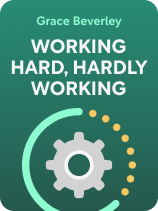

This article is an excerpt from the Shortform book guide to "Working Hard, Hardly Working" by Grace Beverley. Shortform has the world's best summaries and analyses of books you should be reading.
Like this article? Sign up for a free trial here.
Does work drain you or energize you? Do you look forward to starting your work day, or do you dread it?
If all of your enjoyable moments in your day are outside of work hours, Grace Beverley has some good news for you. She says that you don’t need to quit your job or find a new one to find satisfaction throughout your day; you can simply make your current work more enjoyable.
Keep reading to discover how to enjoy work by following Beverley’s recommendations.
How to Enjoy Work
Beverley says you can engage in self-care while working by making your work more enjoyable. That way, your time spent working productively won’t be depleting. Instead, the joy you get from working will energize and satisfy you.
(Shortform note: You may think that making work enjoyable means avoiding effortful, challenging tasks—but some research suggests that doing so would be a mistake. For instance, one study found that challenging tasks may lower your happiness in the present, but these same tasks boost your happiness later when you reflect on them. Therefore, when you’re working, seek out joyful experiences and welcome challenging tasks that will leave you feeling satisfied when you recall them later.)
Beverley’s advice on how to enjoy work includes three recommendations: include micro-passions, use creative triggers, and experience flow.
#1: Incorporate Satisfying Tasks Into Your Workday
First, Beverley recommends ensuring that your workday involves many satisfying tasks (what she calls “micro-passions”). When you fill every day with multiple satisfying tasks, those days amount to a satisfying life.
To implement this tip, make a list of work-related tasks you find satisfying. Then, make a plan to incorporate more of those tasks into your typical workday. Beverley notes that this may require making large changes, such as asking your boss for additional (or different) responsibilities or pursuing professional development that will improve your skills. If those changes aren’t possible, it could be a sign that you should switch roles or careers.
For example, imagine you’re a teacher who enjoys the tasks of supporting your colleagues and learning new teaching techniques. You could ask your boss if you can start mentoring new teachers, or you could seek out professional development opportunities that will expand your teaching skills. If these changes aren’t possible, consider switching to a role in which these satisfying tasks feature prominently, such as becoming an instructional coach (a teacher of teachers).
| Advice on Satisfying Tasks From A Job to Love In A Job to Love, writers from The School of Life share Beverley’s view that a workday consisting of satisfying tasks makes your life more satisfying, and they offer additional advice for identifying and pursuing these tasks. Identifying satisfying tasks: First, the authors describe various types of satisfaction that a job can provide. They say you can clarify your top satisfying tasks by ranking the following twelve types of satisfaction: deepening your understanding; earning money; appreciating beauty; using your creativity; being a leader; expressing yourself; being independent; teaching others; organizing objects and ideas; enjoying nature; helping others; and solving problems using technology. Furthermore, whereas Beverley recommends identifying work-related tasks you find satisfying, the authors of A Job to Love say you can look beyond work to identify the types of tasks that satisfy you. For instance, they recommend reflecting on which of the twelve satisfying tasks you found most enjoyable when you were playing as a child. They say it’s likely your childhood inclinations and interests are still true today. Pursuing satisfying tasks: Like Beverley, the authors of A Job to Love recommend incorporating satisfying tasks into your workday. It may help to consider their advice that no single job will ever fulfill all of your needs. If your current job doesn’t involve enough satisfying tasks, either follow Beverley’s advice to find one that does—or accept that your current job may never be satisfying enough and instead pursue satisfying tasks outside of work. |
#2: Make Your Work Original
Second, Beverley argues that we find work more satisfying when we complete tasks in an original way. She explains that when we leverage our unique strengths to create original work, the result is more valuable because someone else can’t easily replicate it. Feeling valuable in this way gives us joy and satisfaction.
How can you make your work original? Beverley says to engage in warm-ups (what she calls “creative triggers”) that will inspire you to think outside the box before you complete work tasks. Warm-ups she recommends include drawing something relevant to your work task, listening to a podcast on a related topic, and brainstorming relevant ideas with others.
For example, say you’re a musician who posts lessons about musical concepts on YouTube. You begin one workday by doodling on paper while listening to a song you want to teach. This warm-up gives you the idea to represent the song visually in your video for it, using rising lines to represent ascending melodies, falling lines to indicate descending ones, and wavy lines to show vibrato.
#3: Set Yourself Up to Experience Flow
Beverley offers a third tip for making your workdays more enjoyable: experience flow. She explains that, according to psychologist Mihaly Csikszentmihalyi, flow is a state in which you’re deeply absorbed in a task. Beverley says that flow makes productivity a form of self-care because the feeling of being engrossed in a task is joyful and satisfying.
According to Csikszentmihalyi, you experience flow when you’re engaged in a task in which your skill level matches the level of challenge you feel. If you’re not experiencing flow because a task is too easy, you can enter flow by making the task more challenging. If you’re unable to access flow because a task is too difficult, improve your skills.
Beverley advises that it’s easiest to enter flow states when working on tasks that are already conducive to flow. Start by identifying tasks that have put you into a state of flow before.Think of instances in which you felt completely engaged in a work task, such as moments when you lost track of time.
Next, instead of waiting for flow to happen when you engage in these tasks, purposefully initiate flow. Engage in a brief warm-up activity (Beverley calls these “flow triggers”) that inspires you to work on the tasks you identified. For instance, say you’re a graphic designer who has experienced flow in the past when sketching logo ideas. You could initiate flow by looking at pictures of your favorite logos for inspiration before designing your own.

———End of Preview———
Like what you just read? Read the rest of the world's best book summary and analysis of Grace Beverley's "Working Hard, Hardly Working" at Shortform.
Here's what you'll find in our full Working Hard, Hardly Working summary:
- Why self-care and productivity require one another
- How to use your work time wisely and make work tasks more enjoyable
- How regular self-care can help you prevent burnout






